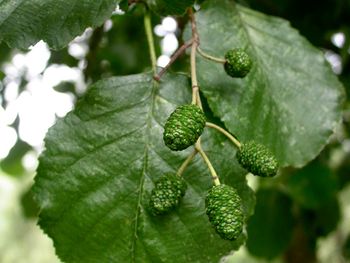Common Alder
Other Names : Alnus glutinosa, Alnus rotundifolia, Betula glutinosa, Black alder, European alder, Alder, Aliso Negro, Alnus barbata, Aulne Glutineux, Aulne Rouge, Aune, Aunette, Betula Alnus, Betula glutinosa, Fever Bush, English Alder, European Alder, European Black Alder, Owler, Winter Berry.
Common alder is a species of tree in the family Betulaceae, native to most of Europe, southwest Asia and northern Africa. Alder belongs to the birch family of the genus Alnus. While this genus includes approximately 30 species of trees and shrubs, the alder tree found in Europe may grow up to a height of even 100 feet.It thrives in wet locations where its association with the bacterium Frankia alni enables it to grow in poor quality soils. Bark and leaves are used. The leaves are harvested in the summer and used fresh. The dried bark of young twigs are used, or the inner bark of branches 2 - 3 years old. It is harvested in the spring and dried for later use.
Special Precautions of Common Alder
The fresh bark will cause vomiting, so use dried bark for all but emetic purposes
Health Benefits and Uses of Common Alder
The bark is alterative, astringent, cathartic, febrifuge and tonic. Alnus species have been used for the treatment of rheumatism, hemorrhoids and for wound healing in folk medicine.
- A decoction of the dried bark is used to bathe swellings and inflammations, especially of the mouth and throat : used as a mouthwash and gargle for throat, gum and tooth problems owing to its astringent properties.
- The powdered bark and the leaves have been used as an internal astringent and tonic
- A decoction prepared with the bark of the alder may also be used to stop internal as well as external bleeding and also to cure injuries.
- A medication prepared with the leaves of the alder is also an effective wash for scabies (a contagious skin infection caused by the itch mite).
- Since the bark is high in tannin, it can be used in all situations where astringency is needed, including diarrhea, and sore throats, and has been known to cure ague.
- A decoction prepared with the bark of the alder is an effective medication to wash swelling and inflammations, particularly of the throat.
- This decoction is said to heal ague (a fit of shivering or shaking).
- Farmers inhabiting the Alps are said to use the alder leaves to alleviate rheumatism.
- Boiling the inner bark in vinegar produces a useful wash to treat lice and a range of skin problems such as scabies and scabs. The liquid can also be used as a toothwash.
- The leaves are astringent, galactogogue and vermifuge. They are used to help reduce breast engorgement in nursing mothers.
- A decoction of the leaves is used in folk remedies for treating cancer of the breast, duodenum, oesophagus, face, pylorus, pancreas, rectum, throat, tongue, and uterus.
- People in Spain curve the leaves of the alder and put them on the soles of aching feet. Herbalists often recommend the alder leaves for nursing mothers to help them lessen the breast inflammations.
- In a research study, extracts from the seeds of the common alder have been found to be active against all the eight pathogenic bacteria against which they were tested, which included Escherichia coli and methicillin-resistant Staphylococcus aureus (MRSA). The only extract to have significant antioxidant activity was that extracted in methanol. All extracts were of low toxicity to brine shrimps. These results suggest that the seeds could be further investigated for use in the development of possible anti-MRSA drugs.
